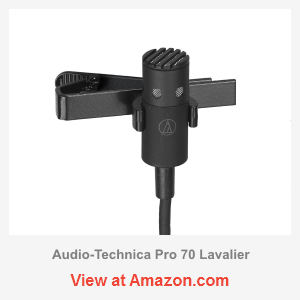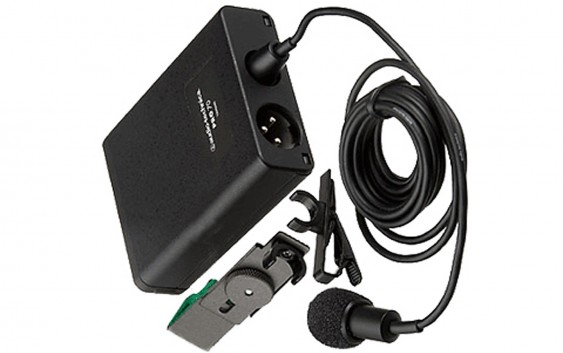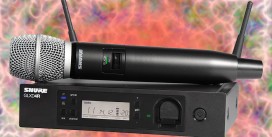AT Pro 70 is an affordable, professional lavalier that comes with a battery pack and a standard XLR output. Ideal for both voice and instruments it also includes a handy instrument mount in the package. This microphone uses phantom power to polarize the capsule. Phantom power can be either supplied externally or generated by the battery. It’s quite useful, especially if your device does not produce the phantom power by itself. Powered by a single AA battery it can work for up to 2 months straight. It uses a cardioid polar pattern with an option for bass roll off apparently to combat the proximity effect.
Sound & quality
Audio-Technica Pro 70 is not high-end, but it does produce a professional sound. It is also very nicely priced and I believe it’s one of the best, if not the best in a $100 price range. Unlike with other cheaper lavalier microphones, the manufacturer actually provides complete specifications for this model, which include frequency pattern and polar diagram. The frequency pattern is a great way of backing up claims about sound quality, and in case with AT Pro 70, it does indeed look great for a lavalier mic. It is overall smooth and has a slightly softer low end that may help in eliminating the proximity mud and vibrational noise.
 Having a cardioid pattern, the pick-up angle is reduced to 120°. This allows to reduce a great bit of environmental noise as well as reverberation but make sure to point it straight up towards your mouth, a guitar hole or whatever the sound source. On the other hand, like all directional microphones it inherits a proximity effect that boosts the low freq. proportionally to the distance. Contrary to the logic, this won’t affect your voice unless you are eating the mic. The problem is it becomes sensitive to handling. Vibrations virtually have zero distance to the capsule so they receive an enormous decibel boost. It isn’t so terrible after all, but it will be heard if you’re rubbing the mic or its wire.
Having a cardioid pattern, the pick-up angle is reduced to 120°. This allows to reduce a great bit of environmental noise as well as reverberation but make sure to point it straight up towards your mouth, a guitar hole or whatever the sound source. On the other hand, like all directional microphones it inherits a proximity effect that boosts the low freq. proportionally to the distance. Contrary to the logic, this won’t affect your voice unless you are eating the mic. The problem is it becomes sensitive to handling. Vibrations virtually have zero distance to the capsule so they receive an enormous decibel boost. It isn’t so terrible after all, but it will be heard if you’re rubbing the mic or its wire.
Design and build
Audio-Technica Pro 70 boasts a sturdy and quality build, which is easy to tell even by looking at the pictures. Starting from the grills, they look quality. You can clearly see a metal screen through the holes that acts as a pop filter and the capsule is well protected. The microphone is hardwired with the power module by a thick 6 feet cable. I usually don’t recommend the hardwired solutions, but this won’t be the case as it still connects with a separate XLR to the body. Perhaps, the pin isn’t that perfect as it keeps on detaching from time to time but at least it will never break. Windscreen sits tightly enough though.
Conclusion
The mic is just awesome for its price and you’ll never get disappointed with the purchase. It does have some minor issues, but which piece doesn’t? What’s more important is that it can be used for a whole lot of things starting from interviews and ending up with music and instrumental recording. Ideal for videographers, public speakers and musicians, AT Pro 70 offers unequalled performance and can probably serve for a good number of years. If you don’t want to invest $400 in a high-end lavalier for a slight, if at all noticeable increase in performance than this is the mic for you.
Pros
|
Cons
|










Hi Peter
I bought a Audio-Technica Pro 70 as a better quality than my Rode lav mic for outside recording with my iPhone XR. It’s other big attraction is it has its own battery (1.5v alkaline) to provide phantom power.
I cannot get a signal through to my iPhone. I have tried 2 different XLR to 3.5mm jack cables – 1 mono and 1 TRS. I have also tried also adding in the ‘chain’ a TRS to TRRS adapter (into a lightning adapter). Still no signal. I use FilmicPro app to record on the iPhone which is great and in the settings for audio I see when the app recognises the ‘headset’ external lav mic connected. I use the XLR to TRS; then into a Rode TRS to TRRS adapter; then a 3.5mm to lightning adapter into the iPhone. It recognises the mic but there is zero level with the mic switched on in both normal and low cut settings.
Any ideas why I get no recording level signal?
Many thanks
Phil. Bakewell, UK
Trrs/trs connectors can have different wiring depending on the application. You need an adaptor that specifically implies microphone usage – better yet search for XLR to Trrs for smartphone mic or lightning directly.
Very click-baity to see this old 2015 review from a search result that claims “Best Lapel Microphones 2021.”
IT’S NOT AN IPHONE, IT’S A MIC. A MIC. OK? GOD DAMMIT.
If you have some better options in mind then go ahead and spit it out, and don’t be a smart ass.
As a teacher in college I have used this AT 70, very satisfied even though it is expensive compared to the Boya Lavalier, the ability to reduce noise especially for echo and feedback is very useful when in a class with poor room acoustics. In different classes when teaching, sometimes the loudspeaker is placed above the teacher’s head so that when using another brand of Lavalier (omnidirectional) there will be feedback
Hi, Peter. Just discovered this site, and finding your reviews enormously helpful. Thanks much for taking the time. Just wondering if you’ve ever reviewed the Shure MX183/184/185 lineup, and if so, how they might stack up against the WL93, WL35 headset, or AT Pro 70. My son and I are culling used gear on the cheap to do a walking podcast outdoors, and so far, our kit includes two Zoom F3 field recorders (w/BT1 adapters), two Shure SM11 dynamic Lavs, and two Shure MX series condenser Lavs with interchangeable capsules (183/185). Still waiting on two WL93s to arrive from ebay. Just wondering if any of these three sets of mics will cut it, or if I’m better off getting two dedicated Shure SM35 headsets and/or two AT Pro 70 Lavs. Yes, realizing I won’t be getting the quality I might get from two DPA, Sanken, or Countryman Lavs, but the prices on used SM35s and AT Pro 70s are so reasonable right now that I wouldn’t mind springing for them if the sound quality were to be a significant step up from my current Shure Lavs. Thoughts?
Thanks for the comments. I’ve looked into Shure MX183 etc. They seem like a slightly older model but with specs that are also quite decent. However, there is nothing that makes them stand out from other budget models aside from looking kinda big/fatty and having an unreasonably higher cost. In my opinion they absolutely don’t worth the extra money, because you could easily add some more and step into a pro territory. However, those who own Shure wireless bodypack transmitter can purchase that version without preamp. It starts with different letters: WL183M etc and those could be a viable option! I would bet they beat WL93 because it’s a budget miniature mic that only features an omnidirectional capsule.